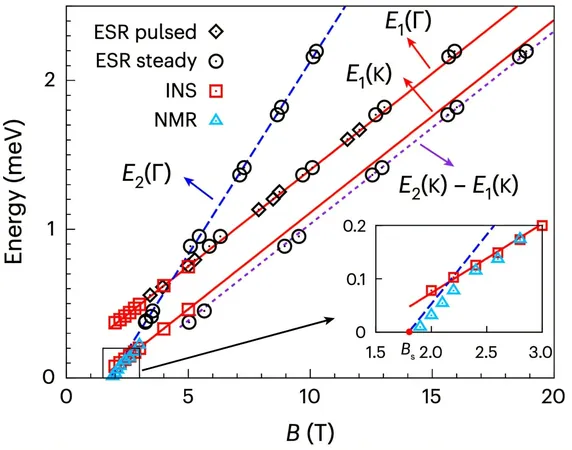
Historic Breakthrough: First-Ever Bose-Einstein Condensation of Two-Magnon Bound State Unveiled!
2025-03-13
Author: Rajesh
Groundbreaking Discovery in Quantum Physics
In a groundbreaking discovery, scientists have observed the first Bose–Einstein condensation (BEC) of a two-magnon bound state in a magnetic material, a feat made possible by the advanced Multi-frequency High Field Electron Spin Resonance Spectrometer at the Steady-State High Magnetic Field Facility (SHMFF) in Hefei, China. This landmark research, published in the prestigious journal Nature Materials, involved a collaboration between researchers from the Hefei Institutes of Physical Science, Southern University of Science and Technology, Zhejiang University, Renmin University of China, and the Australian Nuclear Science and Technology Organization.
Understanding Bose–Einstein Condensation
Bose–Einstein condensation is a remarkable quantum phenomenon where bosons—particles that follow Bose-Einstein statistics—can occupy the same quantum state, effectively behaving as a single entity at extremely low temperatures. While scientists have observed BEC in cold atomic systems for decades, its presence in magnetic systems remained elusive until now, making this discovery a true milestone in quantum physics.
Focus on Magnons and Bound States
The team’s research focused specifically on magnons, the quantized excitations of spins in a magnetic lattice. They found that these magnons can pair up, forming bound states that give rise to a distinct condensed phase akin to that found in ultracold atomic gases. The material central to this discovery, Na₂BaNi(PO₄)₂, possesses a unique triangular lattice configuration, allowing for the exploration of frustrated quantum magnetism—a regime where competing interactions among electron spins lead to unusual and unpredictable behaviors.
A Novel Mechanism of Magnon Pairing
This research marks a significant departure from traditional superconductivity, which typically involves the pairing of fermions. Instead, the scientists unveiled a novel mechanism of magnon pairing that triggers a quantum phase transition, shedding light on exotic quantum states that could revolutionize our understanding of condensed matter physics.
Experimental Validation and Techniques
Utilizing the facilities at SHMFF, the research team successfully identified and measured the otherwise minute signals associated with the two-magnon bound states, aligning their findings with theoretical predictions. Their comprehensive experimental approach employed low-temperature thermodynamics, neutron scattering, and nuclear magnetic resonance techniques, confirming the existence of the magnon BEC.
Implications and Future Research
This watershed moment in quantum research not only contributes to our understanding of quantum materials but also opens the door to the discovery of new phases of matter that may have practical applications in future technologies, such as quantum computing and advanced materials science. As researchers continue to delve into the depths of quantum phenomena, the implications of this work could be far-reaching, potentially revolutionizing various fields and paving the way for innovations that harness the peculiar properties of quantum states. Stay tuned for more updates on this thrilling journey into the quantum realm!



 Brasil (PT)
Brasil (PT)
 Canada (EN)
Canada (EN)
 Chile (ES)
Chile (ES)
 Česko (CS)
Česko (CS)
 대한민국 (KO)
대한민국 (KO)
 España (ES)
España (ES)
 France (FR)
France (FR)
 Hong Kong (EN)
Hong Kong (EN)
 Italia (IT)
Italia (IT)
 日本 (JA)
日本 (JA)
 Magyarország (HU)
Magyarország (HU)
 Norge (NO)
Norge (NO)
 Polska (PL)
Polska (PL)
 Schweiz (DE)
Schweiz (DE)
 Singapore (EN)
Singapore (EN)
 Sverige (SV)
Sverige (SV)
 Suomi (FI)
Suomi (FI)
 Türkiye (TR)
Türkiye (TR)
 الإمارات العربية المتحدة (AR)
الإمارات العربية المتحدة (AR)